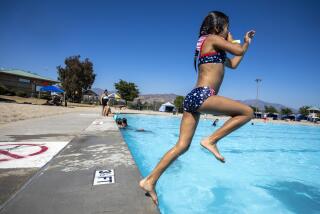Building Safety Into Bathrooms
- Share via
Hot water on demand, potions for primping and pampering, flattering lights, slick surfaces, appealing decor all make the bathroom a pleasurable enough place. But those very features can be hazardous to kids.
“For children, the bathroom is actually one of the two most dangerous rooms in the house. The other is the kitchen,” says Herta Feely, executive director of the National Safe Kids Campaign, a Washington-based group that promotes a safe environment for children.
A complete set of statistics on the number of serious accidents in bathrooms isn’t collected, according to Feely. But there is evidence that a significant number of injuries to children occur in the bath. These include at least 5,000 serious scald-burns from hot tap water and a significant share of the 1 million poisonings recorded each year, as well as slips and falls, drowning and choking.
“Fatalities are rare,” Feely says.
But injuries are not. She cited this 1984 study in the American Journal of Public Health: For every death, 45 children require hospitalization, another 1,300 are treated and released and 2,600 children are treated at home.
The message of safety appears to be getting through to the bath industry. Safety issues were a focus at its annual trade fair in Atlanta in March, where Feely was invited to speak on safety at a seminar for installers and designers.
A safe children’s bathroom also was on display.
“This is the first specifically safety-related prototype bathroom on display in the design ideas section of the show,” says Donna Luzzo, communications director of the National Kitchen and Bath Assn., which sponsors the event.
Among safety-promoting features designed into the room are temperature-limiting faucets for sink, tub and shower and pressure-balanced shower valves that maintain an even temperature even if cold water is turned on elsewhere in the house. There are also magnetic locks on the medicine cabinet and drawers, low-voltage lighting that reduces the chance of electrical shock and a “soft” fiberglass bathtub with a surface layer of urethane foam. The surface is said to pose less risk of serious injury in a fall.
Besides ample floor area for toweling and dressing, the counters and cabinets have rounded corners, heavy-duty grab bars in the tub and separate stall shower and seats in both shower and changing area.
Special bathrooms aside, the developing trend generally is to build safety features into new bathrooms rather than add them later, says Leslie Hart, editor of Kitchen & Bath Business magazine. There’s also more interest in making these features attractive and homelike.
Grab bars, for example, come in bright colors and no longer look like hospital equipment. Magnetic locks on medicine cabinets are unobtrusive, and prefabricated stall showers are being designed with built-in seats. In the past, locks and other safety features usually had to be added, giving the room an institutional look, according to Hart.
The most reliable route to a safe bath for consumers who are adding a bath or remodeling one is self-education, Feely says.
“Whether you prefer a freestanding pedestal sink or a built-in sink, rounded edges will minimize the problem of cuts and abrasions,” she says.
She recommends materials that are not unusually slippery when wet and installing grab bars and a tub with a slip-resistant bottom.
But what about the vast majority of people who aren’t planning to add or remodel a bath?
Anti-scald devices can be added to existing faucets, and a rubber mat can be placed in a bathtub with a slippery bottom. If you have children, keep cosmetics and other potentially hazardous substances out of reach. You can also make your bathroom safer simply by changing your habits, Feely says.
“Remember that hot water is liquid fire to children at certain ages. At 1 1/2, kids turn knobs out of curiosity,” she says. “Don’t leave a young child unattended in the bathroom.”
When running a bath, don’t fill the tub with the hot water first and then the cold, as some people do, she suggests. Instead, mix them. She also advises against leaving a hair dryer plugged in.
More to Read
Inside the business of entertainment
The Wide Shot brings you news, analysis and insights on everything from streaming wars to production — and what it all means for the future.
You may occasionally receive promotional content from the Los Angeles Times.










